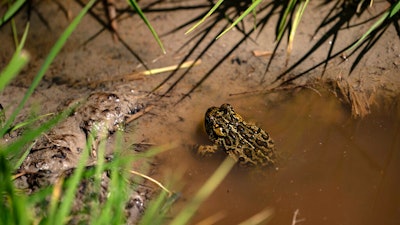
RENO, Nev. (AP) — A tiny Nevada toad at the center of a legal battle over a geothermal power project has officially been declared an endangered species, after U.S. wildlife officials temporarily listed it on a rarely used emergency basis last spring.
“This ruling makes final the listing of the Dixie Valley toad, ” the U.S. Fish and Wildlife Service said in a formal rule published Friday in the Federal Register.
The spectacled, quarter-sized amphibian “is currently at risk of extinction throughout its range primarily due to the approval and commencement of geothermal development,” the service said.
Other threats to the toad include groundwater pumping, agriculture, climate change, disease and predation from bullfrogs.
The temporary listing in April marked only the second time in 20 years the agency had taken such emergency action.
Environmentalists who first petitioned for the listing in 2017 filed a lawsuit in January to block construction of the geothermal power plant on the edge of the wetlands where the toad lives about 100 miles (160 kilometers) east of Reno — the only place it's known to exist on earth.
“We're pleased that the Biden administration is taking this essential step to prevent the extinction of an irreplaceable piece of Nevada's special biodiversity,” said Patrick Donnelly, Great Basin regional director for the Center for Biological Diversity.
The center and a tribe fighting the project say pumping hot water from beneath the earth’s surface to generate carbon-free power would adversely affect levels and temperatures of surface water critical to the toad’s survival and sacred to the Fallon Paiute-Shoshone Tribe.
The Fish and Wildlife Service cited those concerns in the final listing rule.
“The best available information indicates that a complete reduction in spring flow and significant reduction of water temperature are plausible outcomes of the geothermal project, and these conditions could result in the species no longer persisting,” the agency said.
“Because the species occurs in only one spring system and has not experienced habitat changes of the magnitude or pace projected, it may have low potential to adapt to a fast-changing environment,” it said. “We find that threatened species status is not appropriate because the threat of extinction is imminent.”
Officials for the Reno-based developer, Ormat Technology, said the service's decision was “not unexpected” given the emergency listing in April. In recent months, the company has been working with the agency and the U.S. Bureau of Land Management to modify the project to increase mitigation for the toad and reduce any threat to its survival.
The lawsuit over the original plan to build two power plants capable of producing 60MW of electricity is currently before U.S. District Judge Robert Jones in Reno. It's already has made one trip to the 9th U.S. Circuit Court of Appeals, which refused in August to grant a temporary injunction blocking construction of the power plant the bureau approved in December 2021.
But just hours after that ruling, Ormat announced it had agreed to temporarily suspend all work on the project until next year. Then in late October, the bureau and Ormat asked the judge to put the case on hold while Ormat submitted a new plan to build just one geothermal plant, at least for now, that would produce only 12MW of power.
Ormat Vice President Paul Thomsen said in an email to The Associated Press on Thursday that the company disagrees with the wildlife service's “characterization of the potential impacts” of its project as a basis for the listing decision. He said it doesn't change the ongoing coordination and consultation already under way to minimize and mitigate any of those impacts “regardless of its status under the Endangered Species Act.”
“Following the emergency listing decision, BLM began consultation with the FWS, and Ormat has sought approval of a smaller project authorization that would provide additional assurances that the species will not be jeopardized by geothermal development,” he said.
“As a zero-emissions, renewable energy facility, the project will further the Biden administration's clean energy initiatives and support the fight against climate change,” Thomsen said.
Donnelly agreed renewable energy is “essential to combating the climate emergency.”
"But it can't come at the cost of extinction,” he said.
The last time endangered species protection first was initiated on an emergency basis was in 2011, when the Obama administration took action on the Miami blue butterfly in southern Florida. Before that, an emergency listing was granted for the California tiger salamander under the Bush administration in 2002.
Other species listed as endangered on an emergency basis over the years include the California bighorn sheep in the Sierra Nevada in 1999, Steller sea lions in 1990, and the Sacramento River winter migration run of chinook salmon and Mojave desert tortoise, both in 1989.






















